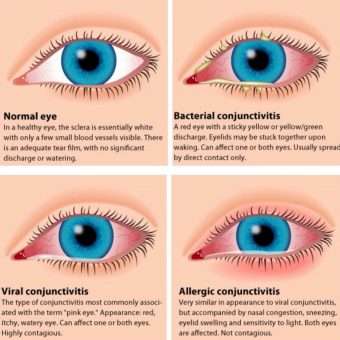Pink eye. The common tongue for what us optometrists call conjunctivitis. There are various types and they’re all treated differently. If you’ve ever gotten it, it can be rather bothersome and sometimes a bit gross (as pus can ooze from your eye – eek!). There’s viral, bacterial, and allergic conjunctivitis. Each of them cause different symptoms and are dealt with differently. It’s best to have an optometrist treat these beasts as we are trained to differentiate between them and know which drug to battle them with – no offense to the wonderful GP’s but we’re just more trained when it comes to the eyes. For appetite reasons, we will keep images to a minimum on this post.

Viral conjunctivitis is probably the worst of all of them – depending on the infecting virus. It can be very contagious. So contagious to the point that you should stay home from work/school/don’t let your child go to daycare because it’s that infectious. Hopefully you never have to deal with this, but in the even that your eye(s) becomes very red, irritated (not itchy), and watery, go see an optometrist and have all linens and towels washed. Let them know your symptoms and they should try to make time to see you. As viruses naturally are, there isn’t really a drop you can prescribe to kill it (depending on the infection). Most of the time, these will go away on their own within 1-2 weeks. Unless it happens to be a herpetic infection, then you need treatment right away to prevent permanent damage. However, discerning whether it’s a mild viral infection versus a herpetic infection is not something you can do on your own, so don’t risk it for the biscuit – because there is no biscuit … only possible vision loss. Definitely not worth losing your vision over taking the time to go see an optometrist to get proper treatment.
Bacterial conjunctivitis is the most apparent beast as it usually involves some sort of discharge/pus coming out of your eye. Your eye(s) will often appear red, be irritated (maybe some itch), and have discharge that is not just tears. The discharge might be coloured – usually yellow. And you may find your eyelids stuck together when you wake up due to discharge drying over your eye lashes and crusting together – not pretty. Same as before, to prevent passing this over to your family members, have your bed linens and towels washed and do not reuse face towels that have touched the oozy eye. Make time to go see your optometrist and get the proper drops that will help to kill the bacteria infecting your eye. After starting the drop regimen, it should take no longer than a week or so to resolve – given that you follow the directions your optometrist gave you. Always ensure you take the drops for the full duration. This will help ensure the bacteria don’t develop resistances to the drugs we prescribe, so they stay effective and stronger drugs are not required. It’s always best to receive the proper treatment rather than “see if it goes away on it’s own”. The risk of the bacteria eventually eating away at your cornea and developing an ulcer is not worth it. It’s easier to deal with infections the earlier they are diagnosed.
Allergic conjunctivitis is definitely more common than the other two – since many of us suffer from allergies. This pickle presents differently. There’s still redness, but it’ll be both eyes and be itchy. There will be a significant amount of watering as well – but no funky colours this time. Allergic conjunctivitis usually occurs for most people when their seasonal allergies start. Unlike the others, this one is not contagious – so no need to hide your kids or wives. Treatment options include cold compresses (to bring down the itchy sensation and inflammation) and either over-the-counter (OTC) or prescription allergy drops. If you’re a seasonal allergy veteran, you can usually predict when your allergies will start. If this is the case, you’re in luck! You can start using the over-the-counter ocular allergy drops 1-2 week prior to when you expect your allergies and this should help prevent the ocular symptoms from occurring. However, if your allergies have already flared up and in full swing, the over-the-counter options won’t work too well. It’s best to visit your optometrist and get a prescription for allergy drops. The reason for this difference is the mechanism for which the OTC and prescription drops work. The OTC works best taken prior to reacting to the allergies because they work to stabilize the cells in your eyes to prevent them from reacting to the allergens. Versus the prescription drops work not only to stabilize the cells (that haven’t reacted), but to treat the activated cells that have already reacted.
To reduce cross-infection and misdiagnosis, it’s always best to visit an optometrist to deal with anything eye related. You’ll get the right treatment and advice on how to prevent recurrences. Be kind to your eyes, you only have two!


Wear sunglasses and avoid touching eyes or nearby area. If you have pinkeye in one eye then it can spread to another eye also. That’s why always wash your hands before touching near the eye.
Thank you so much for your guide. Being an Optometrist this article is really helpful for me. I appreciate you for your quality content which is very rare nowadays. Keep it Up
Thick yellow discharge that crusts over the eyelashes, especially after sleep. It can make your eyelids stick shut when you wake up.